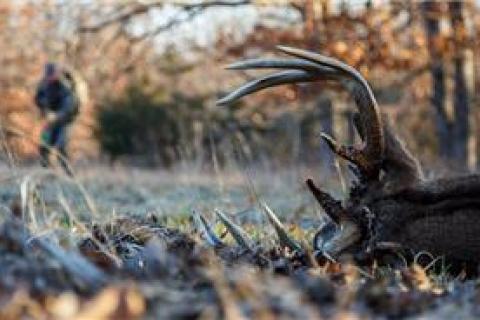
The crowds of deer hunters are gone and the woods are again silent—and that terrain suddenly appears barren to most hunters. You’ve got an unfilled deer tag in your pocket, and you’d like to fill it. The clock is ticking and your hours of opportunity are shrinking. What will you do?
 |
| Taking a big buck during the home stretch of deer hunting season is sure to make you, and your taxidermist, very happy. |
Be positive—and think. There are still deer out there—somewhere. You need to determine where they are, what they are doing, and then make a plan that will put you within range of a deer. Here are some steps to success:
1) Find the Current Foods
White-tailed deer are eating machines, and when they are not eating, they are thinking about the next place they will eat. If there are apples hanging on trees in an orchard, food plots that continue to be green or standing corn, soybeans or other foods that a deer can reach, they will come and dine. Follow some deer trails in your hunting area and pause to make long distance observations with binoculars to determine what deer are currently eating. Then hunt the trails that lead to—or from—that location.
2) Locate Travel Corridors to Bedding Areas
Another route to tag filling success is to determine where deer are bedding, and how they enter and leave those bedding areas. As winter turns cold and raw, deer utilize sun and oftentimes will bed on south facing slopes or in thickets where sun can reach—and warm them. Find the beds and hunt the trails around there. And be watchful during midday when deer can—and do—get up and move.
3) Do a Stalk-n-Shoot
Deer spend longer periods on their beds when winter arrives – they can feel safe there from predators and conserve energy. If you know where you’ve bumped deer in these final days, go there, move into the wind, and slowly begin walking and glassing with binoculars. Reminder: If you are sweating as you hunt, you are moving too fast. Keep a vigil for an ear tip, gleaming eye, or white antlers. Hunters each year move around bedding and feeding areas, or walk parallel to deer trails at a snail’s pace and kill deer. Go get ‘em—in slow gear.
4) Calling all Deer
Late season deer often herd up in big groups, with more eyes being able to easily detect danger, such as sneaky coyotes. Try calling deer with a fawn distress call and be ready. Sounds carry farther during cold, crisp weather, and you can pull in a deer from a great distance away. Doe bleats can also bring in those bucks that are patrolling for a late season doe that has come into estrus.
5) Hunt the High Noon Sun
If your region is blanketed in snow, be afield and on high alert near the noon hour. Deer move when the midday temperatures are warmer, and any other hunters headed for lunch and a warm truck cab for a break can also push deer from beds and feeding areas. Be on your treestand, and be ready.
The key to being afield during the last days and hours of the hunting season when air temperatures can drop dramatically, is staying comfortable and dry. Those are related principles to hunting activity for hunters. Body sweat, snow and rain, and blustery winds can rob you of precious body heat. Cold hunters simply stop hunting. Dress in layers, use air activated warmers if you have to, and wear quality outer layers that keep the moisture away from you. Consider moving out of a treestand and into a hunting ground blind, especially if you have a young or new hunter along.
If you are wearing hunting clothes that keep you warm and comfortable, you will keep hunting.
The deer are out there somewhere. Scout for the up-to-the-minute details, make a plan, and be prepared to stay afield until the last minutes. Some huge bucks that have successfully eluded hunters all hunting season often suddenly appear in hunters’ riflescopes during the last hours of the season.
Learn how to use the weather to your advantage when hunting late season deer at Bass Pro Shops 1Source.
- 7955 views

